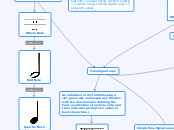Simple time Signatures vs Complex Time Signatures
When the bottom number is only a subdivision of the actual beat note such as in 6/8 or 9/8 time. The time signature indicates how many eighth notes make up the measure, but the real pulse that is felt in the music is the dotted quarter note.
Tip for recognizing - the beat splits evenly into three beats (each of the dotted quarter notes in a measure of 6/8 or 9/8 would split into three eighth notes)
Examples - 6/8, 9/8, 12/8, 6/16, 9/16, 12/16,
Simple Time Signatures
When the number on the bottom is actually the beat note such as in 3/4 or 4/4 time
Tip for recognizing - the beat splits evenly into two beats (each of the quarter notes in 3/4 or 4/4 would split into two eighth notes)
Examples - 2/4, 3/4, 4/4, 5/4, 3/2, 2/2, 4/8, 2/8
What does the bottom number mean?
Type of note that is counted as the beat/receives one beat
Refer to your Rhythm Chart Knowledge
What does the top number mean?
Number of beats in a measure
Rhythm Chart Knowledge
A dot on a note adds half the value (dotted half note = quarter notes) (dotted quarter = 3 eighth notes) (dotted eighth note = 3 sixteenth notes)
Whole Note
Half Note
Quarter Note
Eighth Note
Sixteenth Note
Time Signatures
An indication of rhythm following a clef, generally expressed as a fraction with the denominator defining the beat as a division of a whole note and the numerator giving the number of beats in each bar.
Subtopic

